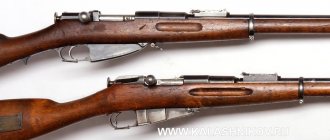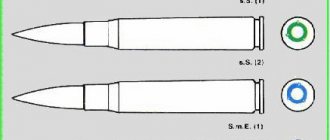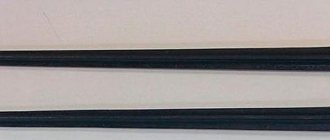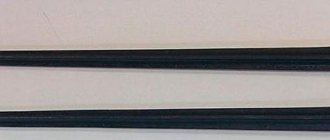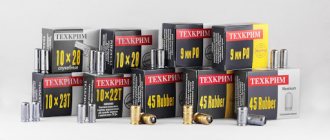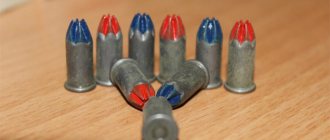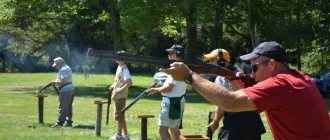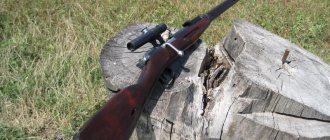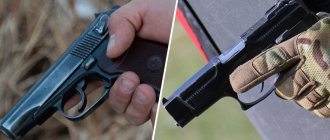Marking of rifle cartridges 7.62x54R for the Mosin rifle.
Production history and
Note
| This mark is applied to a cartridge with a blunt bullet and, in my opinion, is the designation of a trial batch of 1892\or 93\ brass cartridges purchased in France. The number 9 is upside down. Petersburg plant. |
| These marks are found in the literature - the manufacturer is unknown. The latter is designated as - Berndorfer Metallwarenfabrik Arthur Krupp |
| Sleeve manufactured before 1930 with the mark P 41 - ? |
| Only drawings of French marks from the article: K. Soloviev “Russian rifle cartridge” |
cartridges have been capped in cardboard packs - 3 clips of 5 cartridges each, then 20 packs were placed in a zinc box and sealed. Two zinc boxes were placed in a wooden box.
1 2 3
The year, month and day of capping of the cartridges were indicated on the top of the pack valve./ Fig. 1/
The caliber, year and box number were indicated on the zinc box (3 l. 91 No. 000)
The box indicated the box number, the name of the plant, the type of cartridges (B.P. - combat, H.P. - blanks, Uch.P. - training) and their number in the box - 600 pieces.
The supplier and year of manufacture of gunpowder, batch number, etc. were also indicated on the box.
O, Okht – Okhta State Powder Plant St. Petersburg
Shost, Sh – Shostensky state-owned powder factory
K, Kaz - Kazan State Powder Plant
R.O. - plant of the Russian Society for the Production of Gunpowder, Shlisserburg
Then the type of pack changes (it’s difficult to name the year of change, but no later than 1905) /Fig. 2 / and the weight of the powder charge is additionally indicated on the valve /Fig. 3/
Below is a sample of a “report on gas breakthrough during target practice”, which records data taken from the markings on the valve of a pack of cartridges.
During the Russo-Japanese War, the consumption of ammunition exceeded that calculated, including due to the appearance of machine guns. The factories operated at maximum capacity: 200 million in St. Petersburg, 140 million in Lugansk and 125 million cartridges in Tula. European factories were ordered 500 million rounds of ammunition.
| Hirtenberger Patronen-, Zündhütchen-und Metallwarenfabrik A.-G., Hirtenberg, Niederdonau, Austria |
| Weiss Patronenfabrik, Vienna, Austria, although there is no information on the second mark |
| Deutsche Waffen-u. Munitionsfabriken A.-G., , Früher Lorenz , Karlsruhe, Germany marking with raised imprint |
| E. Polte Armaturen und Mascinenfabrik AG, Magdenburg, Germany |
| FN-Fabrique Nationale d'Armes de Guerre, Herstal Belgium |
During World War I, the current need for rifle cartridges was about 3 billion pieces per year. The three cartridge factories that existed in Russia with an annual productivity of only about 550 million cartridges (according to calculations at the end of 1906) could not satisfy it, and they had to resort to ordering cartridges abroad. Orders for Russian 3-line cartridges were placed mainly in America.
The first orders were made in the spring of 1915. In total, 2,250 million rounds of ammunition were ordered in the USA. A characteristic difference is an additional groove on the sleeve in front of the protruding flange and a capsule of smaller diameter (Boxer system), an extruded marking imprint. .
| Winchester Reapeating Arms Company Bridgeport CT |
| Remington Arms Co., Inc. |
| USCCo United States Cartridge Co., Lowell, MA |
In Great Britain, by order of Russia, 3-line cartridges were produced by the following companies:
| Government Cartridge Factory (1-3-4); marking with raised imprint on GF1 |
| Kynoch & Co marking with raised imprint |
| Greenwood and Batley markings with raised or embossed imprint |
| Royal Laboratory, Woolwich |
| Birmingham Metal and Munitions Co. Ltd., Birmingham, raised imprint marking |
| Eley Brothers, Ltd., London |
For more information about English cartridge factories, see “Master Gun” No. 9, 2005. article by Yuri Kask – Collection in the store.
Photos from the WW2 website - a zinc box with cartridges found in battlefields during the Civil War in the Arkhangelsk region, produced by Greenwood and Batley for Russia.
Regarding capsules, I give only their schematic structure
1- Berdan type primer and case anvil with one ignition hole
2- Berdan type capsule and case anvil with two ignition holes
3- American-made Boxer capsule
4- English-made Boxer type capsule
data from the directory "Cartridges and their forensic research" Moscow 1982
The photograph from SUOMALAISET SOTILASPATRUUNAT 1918 - 1945 shows the markings on the clips of this period. On the left are German releases, on the right are those from England. According to this source, American products were produced without clips.
Photos from the site 7.62x54r.net, according to which designations were applied to both Russian pre-revolutionary and Soviet period clips (on the left), and some other English designations (on the right) https://7.62x54r.net/MosinID/MosinAcc.htm# Stripper%20Clips
II · In December 1917, the Council of People's Commissars announced the demobilization of military factories, but by this time the production of ammunition in the country had practically ceased. By 1918, all the main reserves of weapons and ammunition remaining from the World War had already been exhausted. However, by the beginning of 1919, only the Tula Cartridge Plant remained operational. Lugansk cartridge in 1918 was initially captured by the Germans, then it was occupied by Krasnov’s White Guard army.
For the newly created plant in Taganrog, the White Guards took from the Lugansk plant 4 machines from each development, 500 pounds of gunpowder, non-ferrous metals, as well as some finished cartridges.
So Ataman Krasnov resumed production at the RUSSIAN-BALTIC plant Rus.-Balt. acc. association of shipbuilding and mechanical plants. (Founded in 1913 in Revel, in 1915 evacuated to Taganrog, in Soviet times the Taganrog Combine Plant.) and by November 1918 the productivity of this plant had increased to 300,000 rifle cartridges per day (Kakurin N E. “How the Revolution Fought”)
“On January 3 (1919), the allies saw the Russian-Baltic plant in Taganrog already revived and put into operation, where they made cartridges, cast bullets, inserted them into a cupronickel silver shell, filled cartridges with gunpowder - in a word, the plant was already in full operation. (Peter Nikolaevich Krasnov “The Great Don Army”)”
In the Krasnodar Territory and the Urals, cartridges marked D.Z. are found.
Most likely this marking means “Donskoy Plant” in Taganrog
Simbirsk, which was under construction, was under threat of capture. In the spring of 1918 The evacuation of the St. Petersburg Cartridge Plant to Simbirsk began. To establish the production of cartridges, about 1,500 workers from Petrograd arrived in Simbirsk in July 1919.
In 1919, the plant began production, and in 1922, the Ulyanovsk plant was renamed “Plant named after Volodarsky.”
In addition, the Soviet government is building a new cartridge factory in Podolsk. Part of the shell plant, located in the premises of the former, was allocated for it. The remains of equipment from Petrograd were sent there. Since the fall of 1919, the Podolsk plant began to remake foreign cartridges, and in November 1920 the first batch of rifle cartridges was produced.
Since 1924, the production of cartridges has been carried out by the State Association “Main Directorate of Military Industry of the USSR”, which includes Tula, Lugansk, Podolsk, and Ulyanovsk factories.
Since 1928, cartridge factories, in addition to Tula, received numbers: Ulyanovsk - 3, Podolsk - 17, Lugansk - 60. /But Ulyanovsk retained its ZV marking until 1941/
Since 1934, new workshops were built south of Podolsk. Soon they began to be called the Novopodolsk plant, and from 1940 the Klimovsky plant No. 188.
In 1939, the cartridge factories were reassigned to the 3rd Main Directorate of the People's Commissariat of Armaments. It included the following plants: Ulyanovsk No. 3, Podolsk No. 17, Tula No. 38, Experienced Patr. plant / Marina. grove Moscow / No. 44, Kuntsevsky / Red equipment / No. 46, Lugansky No. 60 and Klimovsky No. 188.
The markings of Soviet-made cartridges remain mainly with a protruding imprint. At the top is the number or name of the plant, at the bottom is the year of manufacture . For cartridges from the Tula plant in 1919-20 the quarter is indicated, perhaps in 1923-24 only the last digit of the year of manufacture is indicated, and from the Lugansk plant in 1920-1927. indicates the period (1,2,3) in which they were manufactured. The Ulyanovsk plant in 1919 -30 puts the name of the plant (S, U, ZV) below.
In 1930, the spherical bottom of the sleeve was replaced with a flat one with a chamfer. The replacement was caused by problems that arose when firing the Maxim machine gun. The protruding marking is located along the edge of the bottom of the cartridge case. It was only in the 1970s that cartridges began to be marked with an embossed imprint on a flat surface closer to the center.
There may be other options.
| Factory | Marking | Start of marking | End of marking |
| Tula plant | T | ||
| Lugansk plant | L | ||
| Ulyanovsk plant | WITH | ||
| U | |||
| ZV | |||
| Podolsk plant | PP PPZ | ||
| P | |||
| Klimovsky plant | |||
| Kuntsevsky Moscow | Produced cartridges for ShKAS and with special bullets T-46, ZB-46 Apparently, experimental batches | 1938 ?? |
It is very rare to find shells from the Lugansk plant with the additional designation +. Most likely, these are technological designations and the cartridges were intended only for test firing.
There is an opinion that in 1928-1936 the Penza plant produced cartridges marked No. 50, but it is more likely that this is a vague mark No. 60
Perhaps, at the end of the thirties, cartridges or cartridges were produced at the Moscow Shot Foundry No. 58, which then produced tail cartridges for mortar mines.
In 1940-41 in Novosibirsk, plant No. 179 NKB / People's Commissariat of Ammunition /
produced rifle cartridges.
The case for the ShKAS machine gun, unlike an ordinary rifle case, has, in addition to the factory number and year of manufacture, an additional stamp - the letter “Ш”. Cartridges with a ShKAS case and a red primer were used for firing only from synchronized aircraft machine guns.
Read more: R. Chumak K. Soloviev Cartridges for a supermachine gun Kalashnikov Magazine No. 1 2001
Drawings from the article are presented in the appendix.
Notes:
Finland, which used the Mosin rifle, produced and also purchased from the USA and other countries 7.62x54 cartridges, which are found on the battlefields of the Soviet-Finnish War of 1939 and the Second World War. It is likely that pre-revolutionary Russian-made cartridges were also used.
| Suomen Ampuma Tarvetehdas OY (SAT), Riihimäki, Finland/1922-26/ |
| Valtion Patruunatehdas, Lapua, Finland |
In the 1920-30s, the United States used Mosin rifles left over from the Russian order for training purposes and sold them for private use, producing cartridges for this purpose. Deliveries were made to Finland in 1940
| Remington Arms Co., Bridgeport, CT, /UMC- Union Metallic Cartridge Co. affiliated with Remington Co./ |
| Winchester Repeating Arms Co., Bridgeport, CT Middle picture - East Alton plant Right picture - New Haven plant |
| Western Cartridge Company, East Alton, IL |
During World War I, Germany used a captured Mosin rifle to arm auxiliary and rear units.
| It is possible that, initially, German cartridges were produced without markings, but there will probably no longer be reliable information about this. |
| E. Polte Armaturen und Mascinenfabrik AG, Magdenburg ,Germany |
| Deutsche Waffen-u. Munitionsfabriken A.-G., , Früher Lorenz , Karlsruhe, Germany |
During the civil war, Spain received a large number of various, mostly outdated, weapons from the USSR. Including the Mosin rifle. The production of cartridges was established. It is possible that at first Soviet-made cartridges were used, which were reloaded and new markings were applied to them.
| Fabrica Nacional de Toledo.Spain |
The English company Kynoch supplied cartridges to Finland and Estonia. According to data provided by GOST from P.Labbett & FABrown. Foreign rifle-caliber ammunition
manufactured in Britain. London, 1994." Kynoch signed contracts for the supply of 7.62x54 cartridges: 1929 Estonia (with a tracer bullet) 1932 Estonia (with a heavy bullet weighing 12.12 g.) 1938 Estonia (with a tracer bullet) 1929 Finland (with tracer bullet, armor-piercing bullet) 1939 Finland (with tracer bullet)
| K-(Kynoch Factories, Imperial Chemical Industries Ltd., Birmingham), England G – type of bullet/tracer/ |
This cartridge was produced in the 20-40s in other countries for commercial purposes:
| ARS - it is unlikely that this is A.RS Atelier de Constitution de Rennes, Rennes, France, since the cartridges from this company are RS, most likely equipped in Estonia with the participation of Finland |
| FNC- (Fábrica Nacional de Cartuchos, Santa Fe), Mexico |
| FN-(Fabrique Nationale d'Armes de Guerre, Herstal) Belgium, |
| Pumitra Voina Anonima, Romania Probably for the remaining captured rifles after World War 1, but there is no exact information about the manufacturer |
It is possible that some of the foreign ammunition listed above could have ended up in Soviet warehouses in small quantities as a result of the annexation of the western territories and the Finnish War, and were used, most likely by parts of the “people's militia,” in the initial period of the Second World War. Also now often found during archaeological research of WWII battle sites in Soviet positions are casings and cartridges produced in the USA and England, ordered by Russia for World War I. The order was not completed on time and was already supplied to the White Army during the Civil War. After the end of the civil war, the remains of this ammunition ended up in warehouses, probably used by security units and OSOAVIAKHIM, but they turned out to be in demand with the beginning of the Second World War.
Sometimes, at battlefields, cartridge cases of a 7.7mm English rifle cartridge (.303 British) are found, which are mistaken for 7.62x54R ammunition. These cartridges were used, in particular, by the armies of the Baltic states and in 1940 were used for the Red Army. Near Leningrad there are such cartridges marked V-Rizhsky / VAIROGS, formerly. Sellier & Bellot/
.
In 1882, in Oranienbaum (now the city of Lomonosov, Leningrad region), an Officer Rifle School was created, which included a rifle range, where samples of small arms and cartridges were tested, cartridges from which are still found.
T.museum
Add-ons
For those who are interested in earlier rifle cartridges, here is the information I have:
Cartridge for the Berdan rifle
Tula plant
Petersburg plant
Unfortunately, I have no information on the designations before 1880; most likely the letter B stands for the Vasileostrovsky cartridge case department of the St. Petersburg cartridge plant. and the top sign is the name of the brass manufacturer.
Manufactured by Keller & Co., Hirtenberg Austria, probably commissioned by Bulgaria for the Serbo-Bulgarian War.
Comments and additions are accepted by mail: [email protected] © Andrey.
Thank you very much -
For additional material.
Literature.
-V Fedorov EVOLUTION OF SMALL ARMS Military Publishing House 1938.or Technology - Youth 2005
-Vladimir Mavrodin RUSSIAN RIFLE Leningrad. Leningrad University Publishing House 1984.
— Boris Davydov DOMESTIC CARTRIDGE FACTORIES. Independent Military Review 08/02/2002
— Boris Davydov Cartridge business in Russia. World of weapons 10-11 2005
-BRIEF GUIDE TO RED ARMY SMALL ARMS CARTRIDGES. Military publishing house 1946.
-Magazine “Weapons” Historical series 1/2003 Cartridges.Technology-Youth 2003
-A. Blagonravov MATERIAL PART OF SMALL ARMS. Oborongiz 1945
— A.A Manikovsky. Combat supply of the Russian army during the World War. M. 1937.
— Mikhail Mukhin EVOLUTION OF THE MANAGEMENT SYSTEM OF THE SOVIET DEFENSE INDUSTRY IN 1921-1941. magazine "Domestic History" No. 3, 2000.
-Mika Pitkänen and Timo Simpanen SUOMALAISET SOTILASPATRUUNAT 1918 - 1945 2005
-R.N. Chumak Russian 7.62 mm rifle cartridge St. Petersburg Atlant 2007
-A. Bortsov S. Chelnokov A brief history of the first Russian rifle cartridges. MASTER GUN magazine March-September 2008
Links
https://ww1.milua.org/ - Yuri Minkin’s website “Weapons of the First World War...” A good selection of articles and illustrations on ammunition
https://www.cartridgecollectors.org/ Website of American collectors. Quite a detailed breakdown of manufacturers in alphabetical order in the headstampcodes - about 8000 designations. In the section Wartime Small Arms Ammo Producers of the USA - manufacturers of Small Arms Ammunition in the United States during the war. Cartridges from these factories were used in the USSR during the Second World War.
https://www.municion.org/ Website in Spanish. Dedicated entirely to markings on cartridges. And it is updated and supplemented quite regularly. The explanation is given by type of cartridge. By entering the Fuego Central - central ignition cartridges, we find the desired caliber range, for example 7 a 7.65m / .32 and find the desired cartridge - 7.62x54R. -a total of about 300 different types of cartridges, more than 3,000 stamps. In addition, the BASES DE DATOS provides DWM codes - Códigos de la DWM and German codes - Alemania
Lots of other interesting information.
https://www.bordingl.com/zfondelli.htm Website in Italian. Labeling by country is provided.
The German Codes - For those especially interested. A detailed description of German markings and the ability to determine the type of cartridge by batch number and manufacturer code.
Small Arms Ammunition Identification Guide, Volume 1, Illustrations of markings and identification methods in English. Text in PDF format. For the USSR, mainly from 1943 to 1970.
Forums
If you find a cartridge or cartridge case unknown to you, or are interested in deciphering the markings on it, ask your question on the military archeology forums. There are quite competent people on the forums who will provide you with the necessary information. Just try to correctly describe the sample you have and, if possible, provide photographs. The sleeve length in mm must be indicated. , bullet diameter or estimated caliber, presence of a protruding flange on the cartridge case (R). If this is a photograph of a cartridge, then it is better that the hole drilled in it is visible, i.e. the cartridge is turned into a dummy (without gunpowder).
https://www.trizna.ru/phpBB2/ - the Trizna search association, a very interesting forum for those interested in the technology of the Second World War.
https://reibert.info/forum/ - REIBERT website. Ukrainian forum on the Second World War.
https://talks.guns.ru/static/forumtopics/36.html section “History of Weapons” on talks.guns, a weapons forum. The entire period of history, not only the Second World War.
Forum participants are people from different parts of Russia, Ukraine, the Baltic states, Bulgaria and other countries. And it’s rare that a question doesn’t have the correct answer.
For those who speak English there are forums on the following sites:
https://www.gunboards.com/forums/ https://www.municion.org/ https://www.cartridgecollectors.org/
Additional Information :
R. Chumak K. Soloviev Cartridges for a supermachine gun Kalashnikov Magazine No. 1 2001
Samples of marking (stamping) of ShKAS cartridge cases
Magazine "Weapons" 1/2003(8)
V.S. MIKHAILOV
CARTRIDGE FACTORIES
Tula Cartridge Plant
After the war of 1877-1878. The government recognized the need to build a second cartridge plant, since the Petrograd cartridge plant, which was the only one at that time, could not adequately serve the entire army. Moreover, he was located near the border, in a strategically dangerous zone. The military department did not undertake the construction of the plant, and it was handed over through competition to the private entrepreneur Gillenschmit. The plant was built in Tula, taking into account the advantages of the location of this point in terms of strategy and industrial geography.
Construction began in 1880 and was completed in 1882, when the plant was put into operation. The design capacity of the plant was set at 30 million cartridges per year with one shift and with two shifts - 60 million.
During the first 10 years, the plant produced 4,2-lin. cartridges of the Berdan system, and during this time 483 million of them were supplied to the military department.
In addition to rifle cartridges, the plant produced revolver cartridges, hunting cartridges, and primers for 4.2-lin. cartridges and pistons.
Soon after its founding, the plant began setting up a brass department and already in 1885 began to prepare cartridge brass, first for itself, and soon for the Petrograd cartridge plant, which did not have its own metallurgical production. Before this, the Tula plant had been ordering brass from America for some time, but, despite the good qualities of American brass, it was forced to abandon it due to the difficulty of transport.
In 1890, in connection with the rearmament of the 3-line army. rifles, the Tula plant, on its own initiative, without having any assignments for the GAU, at its own expense, converted to the production of 3-lin. cartridges in the amount of 100 million pieces. in year. The re-equipment took two years.
From 1892 to 1897, the plant fulfilled a five-year order from the GAU for 3-line. cartridges, producing about 100 million per year. There were no further orders for these cartridges, and the plant was forced to close their production and lay off 3,500 workers.
In connection with the transition to the production of 3-line. cartridge The Tula plant began production of nickel silver for bullet casings. Before this, cupronickel had not been produced in Russia. Engineer Marbo was invited from the French cupronickel factory to supervise the production. However, the latter was unable to achieve completely standard qualities of the metal. Due to misunderstandings that arose on this basis with the plant, Marbo left for France without finishing the work. The plant completed production independently and already in 1892 received good cupronickel, and in 1893 it began supplying it to the Petrograd plant.
Due to the unreliable supply of military orders, the Tula plant sought, in parallel with military production, to create civilian production facilities, and in the very first years, along with cartridge brass, it began to prepare commercial grades of brass.
In 1894, the plant established the production of copper samovar parts and utensils. The first ones were prepared on presses and pressing machines. The dishes were made from cupronickel by hand. Samovar parts did well on the market. The dishes, despite their high quality, had poor sales because they were expensive.
Then, in 1896, in connection with the growing demand for red copper products for railways and the chemical industry, the Tula Plant founded a copper rolling department, which opened work in 1898. The production equipment for it was ordered from Belgium, and heavy iron castings for rolling mills were made in Russia.
In 1898, the Tula plant passed from its previous owners, Gillenschmit, Standerschöld and Shekarazin, into the hands of the “Joint Stock Company of Tula Copper Rolling and Cartridge Plants”.
The period 1880-1898, marked by several expansions of the plant, left its marks on the nature of the equipment in the form of a very motley selection of steam engines and boilers of various systems and capacities, scattered across different departments of the plant.
During this period, a school and a welfare society with a shop and a canteen were founded at the plant.
In 1899, the plant again began to receive orders for rifle cartridges, but in very limited quantities. This continued until the Japanese War, when orders increased sharply. Thus, for the period 1892-1906. The production of cartridges was as follows (million pieces):
| 1893 | |
| 1894 | |
| 1895 | |
| 1896 | |
| 1897 | |
| 1898 | |
| 1899 | |
| 1900 | |
| 1901 | |
| 1902 | |
| 1903 | |
| 1904 | |
| 1905 | 51.5 |
Before the Japanese War, the production of gun casings was transferred to the Tula plant from the St. Petersburg Aleksandrovsky plant[5]. A new building was built for him in 1904. The cannon-case production was equipped with a capacity of 3 million cartridges per year. Due to the war, the plant had quite large orders for cannon casings:
| 1904 | 1.500.000 |
of them:
| 3-dm field | 480.000 |
| 47 mm naval | 205.000 |
The rest are 37mm, 47mm, 75mm, 48-lin. and 6-dm marine
| 1905 | 850.000 |
of them
| 3-dm field | 544.000 |
The rest are the same as in 1904.
| 1906 | 940.000 |
of them
| 3-dm field | 619.000 |
The rest are 57mm, 75mm, 48-lin. and 6-dm howitzers.
In the years following the war, orders for cannon casings and rifle cartridges were again sharply reduced to a volume very small compared to the plant's capacity.
| Rifle (millions) | cartridges pcs.) | Cannon (thousands) | sleeves pcs.) |
| Power | Order | Power | Order |
| 19 1Next ⇒ |
History of production and marking of 7.62x54R rifle cartridges for the Mosin rifle.
Since 1891, the production of rifle cartridges of 7.62 caliber began in Russia, which can be divided into four conditional periods: - before 1918, before 1941, 1942-1945 and the post-war period.
This review mainly examines the markings of cartridges for the Mosin rifle, produced in Russia before the start of the Second World War and produced under orders of the Russian Empire. I
The first Russian cartridge plant began to be built in
St. Petersburg
in 1869. Before this, in 1868, a cartridge workshop began operating in the Old Arsenal building on Liteiny Prospekt. The decision to build a cartridge plant in St. Petersburg was explained, first of all, by dependence on imported supplies of raw materials, materials and equipment. The Okhtinsky powder factory was also located nearby. The liner department of the plant was located on Vasilyevsky Island. The plant was one of the most powerful enterprises in Europe with a planned production capacity of 500,000 cartridges daily by 1870.
The results of the Russian-Turkish War, when the St. Petersburg Cartridge Plant did not supply the army with over 190 million cartridges, forced the government to plan the creation of another plant. But there were not enough funds to build a state-owned plant. In 1880, Alexander II approved the regulations on the plant of the merchant of the 1st guild F.G. von Gillenschmidt in Tula
capacity of 30 million rounds per year. In 1881, the plant began production. In 1886 Brass rolling and copper foundry production started operating here, providing raw materials for the manufacture of cartridges not only in Tula, but also in the state-owned plant in St. Petersburg.
In the first years of rearmament of the Russian army with the S.I. rifle. Mosin felt the insufficient productivity of cartridge factories. The army's needs amounted to 1 billion three-line cartridges. The Main Artillery Directorate again began planning the construction of a new state-owned plant. In 1892 they decided to place it in Lugansk
on the site of a former cannon factory, which had been producing cast iron guns to supply the Black Sea Fleet since 1795 and was closed in 1887. In 1895, the Lugansk Cartridge Factory came into operation, capable of supplying 100 million rounds of ammunition per year.
In 1897, the government tried to refuse orders for cartridges from the Tula plant, but in 1899 it again placed an order there.
In March 1916, it was decided to build a new state-owned cartridge factory in Simbirsk
. Construction began in July 1916, but due to problems with the supply of equipment from abroad and revolutionary events, construction stopped.
Russian cartridges /except for the Tula plant/ are characterized by markings with an external (protruding) imprint:
The inscriptions on the pictures are made conditionally (not to scale). Markings are shown from real samples or photographs of cartridge cases. There may be other options.
| Year | Petersburg Cartridge Plant | Tula Cartridge Plant | Lugansk cartridge plant |
| 1890 | |||
| 1891 | |||
| 1892 | — | ||
| 1893 | — | ||
| 1894 | — | ||
| 1895 | |||
| 1896 | |||
| 1897 | |||
| 1898 | |||
| 1899 | |||
| 1900 | |||
| 1901 | |||
| 1902 | |||
| 1903 | |||
| 1904 | |||
| 1905 | |||
| 1906 | |||
| 1907 | |||
| 1908 | |||
| 1909 | |||
| 1910 | |||
| 1911 | |||
| 1912 | |||
| 1913 | |||
| 1914 | |||
| 1915 | |||
| 1916 | |||
| 1917 |
.
Roman numerals presumably indicate the period (4 months) of manufacture of the cartridge. The word “trimester”, often used to decipher this designation, is not suitable, because means "three months" and is equivalent to the term "quarter".
In 1909-1912, cartridges were produced without manufacturer's markings.
It is possible that these were Moscow private ones in Kuntsevo and Maryina Roshcha, which produced mainly hunting cartridges. In addition, in Riga there was a branch of the Austrian joint-stock factory Selye and Bello, which produced revolver and pistol cartridges.
For the production of cartridges, only the Tula plant produced its own brass. For the St. Petersburg and Lugansk plants, brass was purchased from the Rosenkrantz and Franco-Russian factories in St. Petersburg, the Kolchuginsky plant in the Vladimir province, and the Tula plant. In 1902, they began to build a brass-nickel silver plant at the cartridge factory in St. Petersburg, which already in 1904 provided itself with 2/3 of these materials. Therefore, additional designations of brass suppliers were placed on the sleeves:
F – Society of Franco-Russian factories in St. Petersburg
G – Gillenschmidt Trading House Tula
Ch – Chikina Plant
K - Kolchuginsky plant
R - Rosenkrantz St. Petersburg plant ( from November 7, 1922 “Leningradsky.”)
T - Gillenschmidt Tula plant
P – brass-nickel silver plant St. Petersburg
There could be other designations. During the Russo-Japanese War, ammunition consumption exceeded expectations, including due to the appearance of machine guns. The factories received an order for the maximum number of cartridges: 200 million in St. Petersburg, 140 million in Lugansk and 125 million in Tula. 500 million rounds of ammunition were ordered from foreign factories.
| Hirtenberger Patronen-, Zündhütchen-und Metallwarenfabrik A.-G., Hirtenberg, Niederdonau, Austria |
| Weiss Patronenfabrik, Vienna, Austria |
| Deutsche Waffen-u. Munitionsfabriken A.-G., , Früher Lorenz , Karlsruhe, Germany |
| E. Polte Armaturen und Mascinenfabrik AG, Magdenburg ,Germany |
During World War I, the current need for rifle cartridges was about 3 billion pieces per year. The three cartridge factories that existed in Russia with an annual productivity of only about 550 million cartridges (according to calculations at the end of 1906) could not satisfy it, and they had to resort to ordering cartridges abroad.
Orders for Russian 3-line cartridges were placed mainly in America. The first orders were made in the spring of 1915. In total, 2,250 million rounds of ammunition were ordered in the USA. A characteristic difference is an additional groove on the sleeve in front of the protruding flange and a capsule of smaller diameter. .
| Winchester Reapeating Arms Company Bridgeport CT |
| Remington Arms Co., Inc. |
| USCCo United States Cartridge Co., Lowell, MA |
In Great Britain, by order of Russia, 3-line cartridges were produced by the following companies:
| Government Cartridge Factory (1-3-4); |
| Kynoch & Co |
| Greenwood and Batley |
| Royal Laboratory, Woolwich |
| Birmingham Metal and Munitions Co. Ltd., Birmingham, |
| Eley Brothers, Ltd., London |
II
In December 1917, the Council of People's Commissars announced the demobilization of military factories, but by this time the production of ammunition in the country had practically ceased.
By 1918, all reserves of weapons and ammunition remaining from the World War had already been exhausted. However, by 1919, only the Tula Cartridge Plant remained operational. Lugansk cartridge in 1918 was initially captured by the Germans and then by Denikin. Simbirsk, which was under construction, was under threat of capture.
In the spring of 1918 The evacuation of the St. Petersburg Cartridge Plant to Simbirsk began. To establish the production of cartridges, about 1,500 workers from Petrograd arrived in Simbirsk in July 1919.
In 1920, the plant began production, and in 1922, the Ulyanovsk plant was renamed “Plant named after Volodarsky.”
In addition, the Soviet government decides to build a new cartridge factory in Podolsk. They occupied part of a shell factory, located in a building rented in 1915 from. The remains of equipment that had been stuck on the way to Simbirsk from Petrograd were sent there. Since the autumn of 1919, the Podolsk plant began to remake foreign cartridges, and in November 1920 the first batch of domestic small arms ammunition was produced. Since 1924
The production of cartridges is carried out by the State Association “Main Directorate of Military Industry of the USSR”, which includes
Tula, Lugansk, Podolsk, and Ulyanovsk factories.
Since 1928, cartridge factories, in addition to Tula, received numbers: Ulyanovsk - 3, Podolsk - 17, Lugansk - 60. /But Ulyanovsk retained its ZV marking until 1941/
Since 1934, new workshops were built south of Podolsk. Soon they began to be called the Novopodolsk plant, and from 1940 Klimovsky plant No. 188. In 1939
cartridge factories were reassigned to the 3rd Main Directorate of the People's Commissariat of Armaments.
It included the following plants: Ulyanovsk No. 3, Podolsk No. 17, Tula No. 38, Experienced Patr.
plant / Marina. grove Moscow / No. 44, Kuntsevsky / Krasny sniruzhatel / No. 46, Lugansky No. 60 and Klimovsky No. 188. Markings of Soviet-made cartridges remain mainly with a protruding imprint. At the top is the number or name of the plant, at the bottom is the year of manufacture. For cartridges from the Tula plant in 1919-20 the quarter is indicated, perhaps in 1923-24 the last digit of the year of manufacture is indicated, and from the Lugansk plant in 1920-1927. indicates the period (1,2,3) in which they were manufactured. The Ulyanovsk plant in 1928 -29 puts the name of the plant below.
In 1930, the spherical bottom of the sleeve was replaced with a flat one with a chamfer. The replacement was caused by problems that arose when firing the Maxim machine gun. The protruding marking is located along the edge of the bottom of the cartridge case. It was only in the 1970s that cartridges began to be marked with an embossed imprint on a flat surface closer to the center.
| Factory | Marking _ | Start of marking | End of marking |
| Tula plant | T | 1918 | 1937 |
| 38 | 1938 | 1941 | |
| Lugansk plant | L | 1919 | 1927 |
| 60 | 1928 | 1941 | |
| Ulyanovsk plant | WITH | 1919 | 1924 |
| U | 1925 | 1927 | |
| ZV | 1928 | 1941 | |
| 3 | 1942 | ||
| Podolsk plant | PP PPZ | 1920 | 1920 |
| P | 1921 | 1927 | |
| 17 | 1928 | 1941 | |
| Klimovsky plant | 188 | 1936 | 1941 |
There is unverified information that in 1928-1936 the Penza plant produced cartridges marked No. 50 and in 1941 in Novosibirsk, plant No. 179 NKB produced rifle cartridges.
The case for the ShKAS machine gun, unlike an ordinary rifle case, has, in addition to the factory number and year of manufacture, an additional stamp - the letter “Ш”.
Notes: Finland, which used the Mosin rifle, produced and purchased 7.62x54 cartridges from the USA, which are found on the battlefields of the Soviet-Finnish War of 1939 and WWII.
| Seamen Ampumatarvethedas OY (Sako), Finland |
| Valtion Patruunatehdas, Lapua, Finland |
| Winchester Repeating Arms Co., Bridgeport CT, USA for Finland |
In the 1920-30s, the United States used Mosin rifles left over from the Russian order for training purposes and sold them for private use, producing cartridges for this purpose.
| Remington Arms Co., Bridgeport, CT |
| Winchester Repeating Arms Co., Bridgeport, CT |
| Western Cartridge Company, East Alton, IL |
During World War I, Germany had the Mosin rifle in service with auxiliary and rear units.
| E. Polte Armaturen und Mascinenfabrik AG, Magdenburg ,Germany |
| Deutsche Waffen-u. Munitionsfabriken A.-G., , Früher Lorenz , Karlsruhe, Germany |
During the civil war, Spain received a large number of various, mostly outdated, weapons from the USSR. Including the Mosin rifle. The production of cartridges was established. It is possible that at first Soviet-made cartridges were used, which were reloaded and new markings were applied to them.
| Fabrica Nacional de Toledo.Spain |
This cartridge was produced in the 20-40s in other countries for commercial purposes:
| ARS –( Atelier de Constitution de Rennes, Rennes), France |
| FNC- (Fábrica Nacional de Cartuchos, Santa Fe), Mexico |
| FN-(Fabrique Nationale d'Armes de Guerre, Herstal) Belgium, |
| K-(Kynoch Factories, Imperial Chemical Industries Ltd., Birmingham), England |
It is possible that some of the foreign ammunition listed above could have ended up in Soviet warehouses in small quantities as a result of the annexation of the western territories and the Finnish War, and were used, most likely by parts of the “people's militia,” in the initial period of the Second World War. Also now often found during archaeological research of WWII battle sites in Soviet positions are casings and cartridges produced in the USA and England, ordered by Russia for World War I. The order was not completed on time and was already supplied to the White Army during the Civil War. After the end of the civil war, the remains of this ammunition ended up in warehouses, probably used by security units and OSOAVIAKHIM, but they turned out to be in demand with the beginning of the Second World War. Sometimes, at battlefields, cartridge cases of a 7.7mm English rifle cartridge (.303 British) are found, which are mistaken for 7.62x54R ammunition. These cartridges were used, in particular, by the armies of the Baltic states and in 1940 were used for the Red Army. Near Leningrad there are such cartridges marked V Riga / Sellier & Bellot/. Later, such cartridges of English and Canadian production were supplied under Lend-Lease. III
In 1941, all factories except Ulyanovsk were partially or completely evacuated, and the old factory numbers were retained in the new location. For example, the Barnaul plant, transported from Podolsk, produced its first products on November 24, 1941. Some plants were re-established. The numbering of all cartridge production is given, since there is no exact data on the range of products they produce.
| Markings from 1941-42 | Plant location | Markings from 1941-42 | Plant location |
| 17 | Barnaul | 529 | New Lyalya |
| 38 | Yuryuzan | 540 | Irkutsk |
| 46 | Sverdlovsk | 541 | Chelyabinsk |
| 54 | Nytva | 543 | Kazan |
| 60 | Frunze | 544 | Glazov |
| 188 | Novosibirsk | 545 | Chkalov |
When restored in 1943-1944, the factories received new designations.
| Tula plant | 539 |
| Lugansk plant | 270 |
| Podolsk plant | 710 |
| Klimovsky plant | 711 |
| Kuntsevo plant | 304 |
There may be other designations. For example, plant No. 10 in 1944, but its location is unknown, perhaps it is the Perm plant.
IV
In the post-war years in the USSR, the factories in cartridge production remained in
Klimovsk-No. 711, Tula-No. 539, Voroshilovgrad/Lugansk/-No. 270, Ulyanovsk-No. 3, Yuryuzan-No. 38, Novosibirsk-No. 188, Barnaul-No. 17 and Frunze-No. 60.
The markings of rifle cartridges from this period of production remain primarily with a raised imprint. At the top is the plant number, at the bottom is the year of manufacture.
In 1952-1956, the following designations are used to indicate the year of manufacture: G = 1952, D = 1953, E = 1954, I = 1955, K = 1956. After the Second World War, this cartridge was also produced in the Warsaw Pact countries, China, and the Arab countries of Iraq and Egypt. Possible designations
| Czechoslovakia | aym bxn zv |
| Bulgaria | 10 |
| Hungary | 21 |
| Poland | 21 343 |
| Romania | 22 |
| Yugoslavia | P P U |
| China | 31 51 61 71 321 671 |
This cartridge is still produced at Russian factories in combat and hunting versions.
Modern names and some of the commercial markings on Russian cartridges since 1990
| Tula Plant-JSC Tula Cartridge Plant | TCW,TPZ, WOLF |
| Ulyanovsk Plant - Federal State Unitary Enterprise PA Ulyanovsk Machine-Building Plant | |
| Barnaul Plant – JSC Barnaul Machine Tool Plant | |
| Klimovsky Plant - NPO CJSC KLIMOVSKY SPECIALIZED CARTRIDGE PLANT", FSUE TsNIITochMash | |
| Novosibirsk Plant-JSC Novosibirsk Plant of Low-Voltage Equipment | LVE |
In this article, most of the data is obtained on the basis of available cartridge case samples, but, given the lack of official information on this topic, it is not complete enough.
This is what the entire section “Stamps on cartridges of Russian pre-revolutionary and Soviet production” looks like in the official criminalistic reference book of 1982. And most of the marks of the section are designated as unknown (not only rifle cartridges are shown in the picture)
From the author. Royal Russia. The shine of golden domes and shoulder straps, the splendor of palaces. And the cartridges have clear markings that are gradually updated from year to year. Revolution, collectivization, Cheka, industrialization and NKVD, war. And on the cartridges, numbers quickly replace letters. And only when they appear, they are replaced with new ones. This is how the people who invented them change, replacing those who were shot and exiled. The Brezhnev era or stagnation, as it is called now. The history of markings from this period is contained in two lines. Everything is unchanged. And again history repeats itself. Privatization, MMM. Some of the usual designations on cartridges disappear, and LVE, BSZ, WOLF, which are not clear to everyone, appear...... And a few half-erased numbers on a cartridge case found in a buried trench or on a cartridge kept by your grandfather, as a memory of the past war, are inextricably linked with the history of our country, its ups and downs. In 1882, in Oranienbaum (now the city of Lomonosov, Leningrad region), an Officer Rifle School was created, which included a rifle range, where samples of small arms and cartridges were tested, cartridges from which are still found. Most of the above information was provided by the director of the local history museum of the Lomonosov district of the Leningrad region, Vladimir Andreevich Golovatyuk , who has been involved in the history of small arms and ammunition for many years. The museum has collected a lot of materials and exhibits on the history of the area, military operations in the area during the Second World War. Excursions are regularly held for schoolchildren and everyone interested. . t.museum Comments and additions are accepted by mail : serv [email protected] yandex . ru Andrey.
Many thanks to Alexey from Minsk for the additional material.
Literature.
-V Fedorov EVOLUTION OF SMALL ARMS Voenizdat 1938. -Vladimir Mavrodin RUSSIAN RIFLE Leningrad. Leningrad University Publishing House 1984. - Boris Davydov DOMESTIC CARTRIDGE FACTORIES. Independent Military Review 08/02/2002 - Mikhail Mukhin EVOLUTION OF THE MANAGEMENT SYSTEM OF THE SOVIET DEFENSE INDUSTRY IN 1921-1941. magazine "Domestic History" No. 3, 2000.
-BRIEF GUIDE TO RED ARMY SMALL ARMS CARTRIDGES. Military publishing house 1946.
-A. Blagonravov MATERIAL PART OF SMALL ARMS.
Oborongiz 1945 -Magazine "Weapons" Historical series 1/2003 Cartridges.Technology-Youth 2003 - A.A Manikovsky. Combat supply of the Russian army during the World War. M. 1937. Links
https://www.cartridgecollectors.org/ Website of American collectors.
Quite a detailed breakdown of manufacturers in alphabetical order in the headstampcodes
- about 8000 designations.
In the section Wartime Small Arms Ammo Producers of the USA -
manufacturers of Small Arms Ammunition in the United States during the war.
Cartridges from these factories were used in the USSR during the Second World War. https://www.municion.org/ Website in Spanish. Dedicated entirely to markings on cartridges. And it is updated and supplemented quite regularly. The explanation is given by type of cartridge. By entering the Fuego Central
- central ignition cartridges, we find the desired caliber range, for example
7 a 7.65m / .32
and find the desired cartridge -
7.62x54R.
-a total of about 300 different types of cartridges, more than 3,000 stamps.
In addition, the BASES DE DATOS
contains DWM codes
- Códigos de la DWM
and German codes -
Alemania
. Lots of other interesting information.
https://www.bordingl.com/zfondelli.htm Website in Italian.
Labeling by country is provided. The German Codes - For those especially interested. A detailed description of German markings and the ability to determine the type of cartridge by batch number and manufacturer code. Small Arms Ammunition Identification Guide, Volume 1, Illustrations of markings and identification methods in English. Text in PDF format. Across the USSR, mainly from 1943 to 1970. Additional information:
R. Chumak K. Solovyov Cartridges for super-machine guns Kalashnikov Magazine No. 1, 2001.
Samples of markings (stamping) of ShKAS cartridge cases
